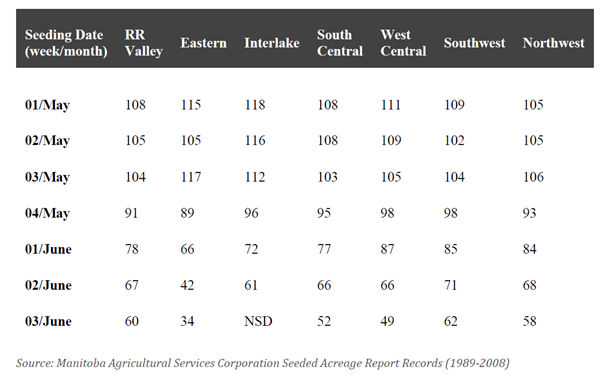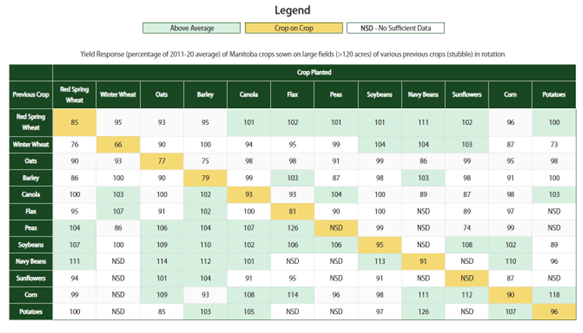Seeding Flax to Provide the Best Start
Typically, flax is seeded from May 1st to June 20th. It may be seeded the last out of all the crops as the bolls and seeds can stand and ripen in the fall without shelling while other crops like canola are being harvested. Prolonged exposure to fall weather, though, will reduce the quality of the harvested seed and make it ineligible for a food grade market. MASC data has shown that flax has good yield potential in the last week of May (Table 1), but yields decline in some areas as the calendar turns to June. MASC seeding deadline is June 20th for all of Manitoba.

Table 2: Relative Stubble Yield Response (2011 – 2020). Source: Manitoba Agricultural Services Corporation.
Yield response data from MASC, recorded from 2011 – 2020 (10 year results), shows that flax responds best when seeded following a pea crop, with the next best response after corn (Table 2). It generally has the poorest yield response when seeded following any oilseed crop, for obvious reasons. Research has shown that flax performs poorly specifically after canola and/or mustard, and not only because of disease issues. The poorer performance of flax on canola stubble is attributed to mycorrhizae fungi which do not associate strongly with canola and decrease in presence during the canola crop’s growing season. When flax is grown on canola stubble, the mycorrhizae populations are lower, which leads to poorer early season nutrient update, especially phosphorus, a relatively immobile nutrient in the soil that is crucial to early flax development.
Flax does well after cereals or corn. It also performs well after legume crops and alfalfa, but Rhizoctonia disease may be a problem. Flax does not do well after potatoes due to the loose seedbed and potentially Rhizoctonia in this rotation as well. According to MASC, the most common crop stubble that flax is seeded into is spring wheat in Manitoba and very few acres are seeded into pea stubble, so that flax-on-pea yield data in Table 2 could be seen as skewed. Crop rotation is extremely important when making all cropping decisions, but flax is a particularly sensitive plant to many outside factors and rotation should be paid considerably close attention to. It is recommended to have at least three years between flax crops on a field to control various soil-borne or stubble-borne diseases of flax, such as pasmo.

Table 2: Relative Stubble Yield Response (2011 – 2020). Source: Manitoba Agricultural Services Corporation.
For a successful flax crop, the greatest strategy is to enable the crop to emerge in a uniform and dense plant stand. This helps the crop with weed control throughout the season and allows for consistent physiological maturity down the road.
Tips for a productive flax plant stand:
- Target ½ to ¾ inch seeding depth to allow crop to emerge quickly
- Do not overfertilize. Flax does not respond positively to increased rates of fertilizer. Excess nitrogen will cause prolonged maturity and potential lodging issues.
- Target a higher seeding rate. Flax depends very heavily on adequate stand establishment and plant populations of 40 – 56 plants/ft2. Typical emergence for flax is 50% – 60% of seeding rate. Seeding rates on the high end of the recommended range should be used for ground prone to crusting when seeding late or under heavy weed pressure.
- Do not seed flax on poorly drained soils or sandy soils because of poor water retention. Medium to heavy-textured soils are preferable. These soils may also crust in the spring, which can inhibit flax emergence.
For more information on growing flax on the Prairies, see Flax Production Resources on our website.
